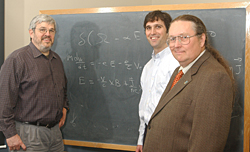
The grants, which total $2.4 million, include a three-year $988,995 grant from NASA's Heliophysics Theory Program to support William Matthaeus and John Bieber, professors of physics and astronomy, and Michael Shay, assistant professor of physics and astronomy, in a study of energy regulation in the solar and interplanetary environments.
Matthaeus also is the recipient of an NSF Solar, Heliospheric, and Interplanetary Environment (SHINE) grant to study the structure and topology of interplanetary magnetic fields. Funding for the first year of the program is $100,140.
“We have maintained a pretty high level of grant funding over the past two decades,” Matthaeus said. “One of the things we do is seek to predict the strength of magnetic storms that can hit the earth and to allow agencies to take preventive action when possible. We do this by observations, theoretical math and computer simulation modeling.”
NASA also selected Bieber as principal investigator for a pair of new, three-year projects based on the use of neutron monitor data and muon detectors to understand the space radiation environment.
Funding for the first program, which will study extreme solar energetic particle events, is $110,000 for the first year. Another $130,000 is earmarked for the first year of the second program, which supports research to predict changes in the interplanetary magnetic field.
“There is a strong training aspect that these grants help make possible,” Bieber said. “We have strong international connections, and there are a growing number of grad students and post doctoral fellows who come here because of the various aspects of space physics that we cover.”
NASA's Magnetosphere Multiscale Mission has awarded Shay a 10-year subcontract award for long-term theoretical support, with budgets ranging from $30,000-$50,000 per year. Shay also was named as a principal investigator of a NASA Geospace Science program grant to study small-scale plasma activity during reconnection. First-year funding for the project to study turbulence effects on magnetic reconnection will be for $116,000.
“The study of plasma physics in general and space weather more specifically is very important,” Shay said. “The people who come through our program tend to do pretty well. These grants have helped us to set up the kind of research group we wanted.”
Article by Jerry Rhodes
Photo by Duane Perry

